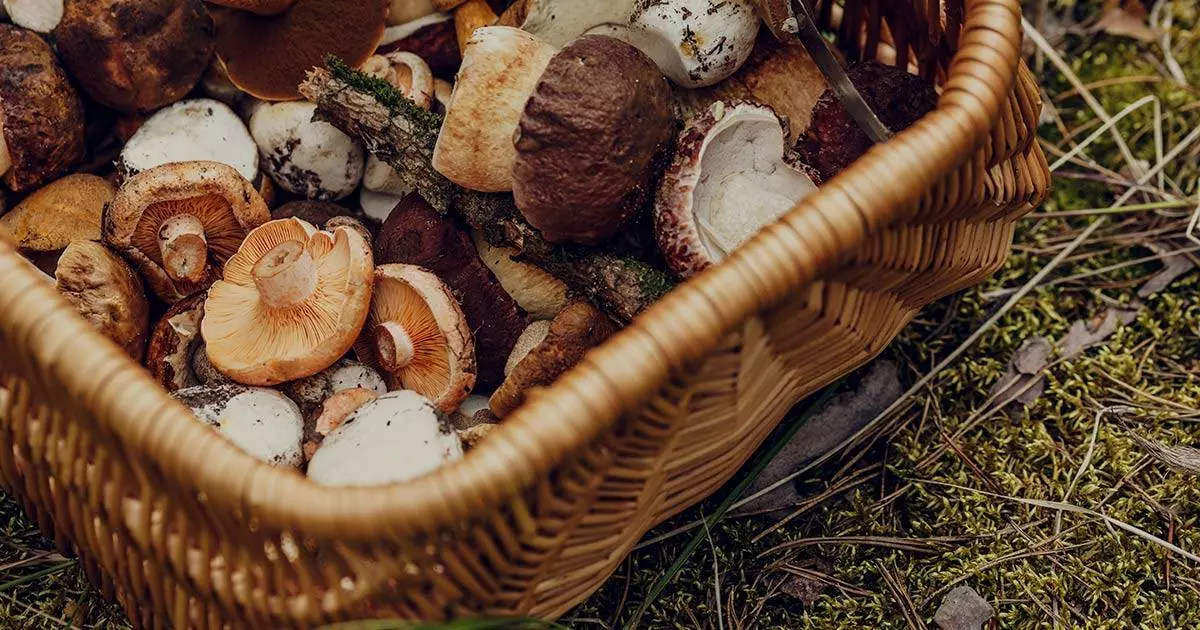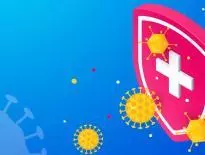There seems to be more and more chatter about the health benefits of mushrooms lately. And I have no problem with the additional interest in mushrooms!
As long as I can remember, I’ve been obsessed with these phenomenal fungi!!
I can also guarantee my Mom will cringe when reading this article. Sadly, she’s not a fan…
It’s already established mushrooms are good for you. And additional health benefits of mushrooms that are coming to light are piling up!
It’s very exciting (to me)! So let’s take a closer look and determine just how good mushrooms are for us.
Glynn’s Guide:
Takeaways That Won’t Fail You
- When shopping for powdered mushroom supplements, make sure it contains both the fruiting body and the mycelium.
- Most gourmet and medicinal mushrooms need to be cooked before consumption.
- The indigestible fiber makeup of the cell walls, (chitin and beta-glucan) have positive benefits for both our health and the health of our gut’s microbiota.
- The common theme I found that continued to surface was the use of medicinal mushrooms as cancer prevention and as part of a cancer treatment arsenal.
- Unless you’re an expert in mushrooms, DON’T consume mushrooms you find in the wild.
- If you haven’t explored gourmet mushrooms, you owe it to yourself to try them with an open mind. They’re all very different.
Table of Contents
Click to Jump to a Section
Nutritional makeup
Are all mushrooms edible?
Can you eat raw mushrooms?
The most beneficial mushrooms (that you’ve heard of)?
What are the beneficial claims of medicinal mushrooms?
Are some of the health benefits of mushrooms real?
Chitin
Beta-glucans
Erinacines
Hericenones
Are powdered mushrooms as a supplement or nutraceutical effective?
Mushroom coffee benefits
Does it matter where mushrooms are grown?
What are some concerns about eating mushrooms?
Mushrooms and candida
Mushrooms and our gut microbiome
What about poisonous mushrooms?
Psilocybin and anxiety, depression and PTSD
Conclusion
FAQs
Research and Resources
Nutritional Makeup of Mushrooms
First, it’s worthwhile to mention that most mushrooms are high in protein. In fact, most are a great source of all essential amino acids.
They’re also a great source of complex carbohydrates. In other words, they will not spike your insulin.
Also, of importance is their indigestible fiber makeup. A lot of the research on this aspect of mushrooms led to the reinforcement of their medicinal value. Their cell walls are made up of chitin and Beta-Glucans. More on that further down the article.
Peter Cheung included the following table in his paper “Mini-review on edible mushrooms as a source of dietary fiber: Preparation and health benefits.” All data is in percentages.
| Species | Common Name | Crude Protein | Crude Fat | Carbs | Crude Fiber | Ash |
|---|---|---|---|---|---|---|
| Agaricus Bisporus | Button Mushroom | 23.9-34.8% | 1.7-8.0% | 51.3-62.5% | 8.0-10.4% | 7.7-12.0% |
| Auricularia Aauricula-Judae | Black Fungus | 8.1% | 1.5% | 81.0% | 6.9% | 9.4% |
| Boletus Edulis | Cep | 29.7% | 3.1% | 58.8% | 10.1% | 7.0% |
| Cantharellus Cibarius | Chanterelle | 21.5% | 5.0% | 64.9% | 11.2% | 8.6% |
| Grifola Frondosa | Maitake | 21.1% | 3.1% | 58.8% | 10.1% | 7.0% |
| Hericium Erinaceus | Monkeyhead | 22.3% | 3.5% | 57.0% | 7.8% | 9.4% |
| Lentinus Edodes | Shiitake | 13.4-17.5% | 4.9-8.0% | 67.5-78.0% | 7.3-8.0% | 3.7-7.0% |
| Pleurotus Ostreatus | Oyster Mushroom | 10.5-30.4% | 1.6-2.2% | 57.6-81.8% | 7.5-8.7% | 6.1-9.8% |
| Tremella Fuciformis | White Jelly Fungus | 4.6% | 0.2% | 94.8% | 1.4% | 0.4% |
| Tricholoma Giganteum | Matsutake | 16.1% | 4.3% | 70.1% | 4.5% | 5.0% |
| Tuber Melanosporum | Black Truffle | 23.3% | 2.2% | 66.2% | 27.9% | 8.3% |
| Vovariella Volvacea | Straw Mushroom | 30.1% | 6.4% | 50.9% | 11.9% | 12.6% |
A quick review discloses that the different variations of mushrooms are all very different in their protein, fat, carbohydrate and fiber makeup. Again, these numbers are percentages.
But there are a few important takeaways on the health benefits of mushrooms:
You can obtain a decent amount of protein from mushrooms. In fact, oyster mushrooms are high in BCAA’s.
Daily consumption of mushrooms can provide up to 25% of your daily fiber needs.
So, to recap, mushrooms are high in:
- Protein
- Fiber
- B vitamins
- Antioxidants
- Many unique compounds that have medicinal value. We’ll discuss those further down the article.
Are all mushrooms edible?
Not all medicinal mushrooms are edible.
Some of the medicinal mushrooms require the extraction of key components for use. And some medicinal mushrooms can be cooked and eaten. There’s a far larger variety of this wonderful fungus than most people realize.
Some of the medicinal properties lie within the mycelium (root system). And you certainly wouldn’t add mycelium to your stir fry!
Then there are the poisonous mushrooms that can cause a range of severe GI disorders to death. So, if you’re not an expert on mushrooms, simply DON’T consume wild mushrooms.
Can you eat raw mushrooms?
Some mushrooms are edible raw, but most should be cooked. Some of the more common mushrooms you find in the grocery store (Portabella, button, and Crimini to name a few) can be eaten raw. But, I caution you if you do not eat a lot of mushrooms. Start with just a few raw or you’ll end up with some GI distress.
As previously discussed, the cell walls contain chitin. And chitin cannot be digested by most humans. Too much and you may experience some diarrhea or GI pain.
So, when in doubt, cook your mushrooms. Besides, many of the flavors are enhanced through cooking.
Two of the easiest and tastiest ways to prepare mushrooms is to either stir fry or roast them. There are more than enough recipes available in the internet universe to quench your palette.
What are the most beneficial mushrooms (that you’ve heard of)?
This is not a complete list. Only the more common mushrooms.
The following fungi show promise (in no particular order):
- Maitake (Grifola Frondosa)
- Cordyceps (Cordyceps Militaris)
- Lion’s mane (Hericium Erinaceus)
- Shiitake (Lentinula Edodes)
- Reishi (Ganoderma Lucidum)
- Coriolus, aka Turkey tail (Trametes Versicolor)
- Chaga (Inonotus Obliquus)
What are the beneficial claims of medicinal mushrooms?
There is a growing list of claims to the health benefits of mushrooms. And each variety of mushrooms comes with slightly different claims.
Let’s look at each mushroom individually with its potential or claimed benefits.
Maitake Mushroom Health Benefits
It has been stated that it improves type 2 diabetes by lowering blood sugar levels. But there are a lot of ways to improve blood sugar levels. It shows more promise working synergistically with pharmacological cancer treatments.
Cordyceps Mushroom Health Benefits
The list is long, but it can be summarized as a mushroom that improves energy levels. It may also assist with asthma. I found mixed results in the literature about asthma. Again, a few connections to help mitigate the effects of pharmacological cancer treatments.
Lion’s mane Mushroom Health Benefits
This particular mushroom is said to help stimulate nerve growth factor. It’s this particular aspect that is placing it in the spotlight of dementia and Alzheimer’s research. Lion’s mane contains erinacines and hericenones. We’ll discuss those below.
Shiitake Mushroom Health Benefits
It has long been used as a cancer treatment in Asian countries. It may also help control cholesterol levels.
Reishi Mushroom Health Benefits
The two most popular species of this mushroom are black and red reishi. They may assist with chemotherapy in cancer treatment. It’s also been shown to help with insomnia, allergies and auto-immune diseases.
Turkey Tail or Coriolus Mushroom Health Benefits
It’s shown to aid in the treatment of cancer. It also has antiviral and anti-fungal properties.
Chaga Mushroom Health Benefits
It too aids in the treatment of cancer. It’s also shown to help with psoriasis.
There’s certainly a common theme in cancer treatment or prevention with mushrooms. Whether it helps or not, I think they’re a great addition to one’s diet or supplement arsenal.
Are some of the health benefits of mushrooms real?
They have unique dietary fiber make-up different from many fibrous foods. And they include some trace nutrients that we’re still learning about.
After a thorough literature review, I have to say there’s enough evidence to both:
- Further the research and
- Add them to your diet or supplement arsenal
So, yes, based on the peer-reviewed research, some of the health claims are real.
Now, let’s get back to the structural differences that have an impact on our health.
What is chitin?
Chitin makes up a portion of the cell wall in fungus (mushrooms). It’s one of the components of the indigestible fiber in mushrooms. It also makes up the exoskeleton of insects and other types of marine life.
As a side note, the chitin that makes up the exoskeleton in insects is a little different than the chitin in mushrooms. And there is less chitin in mushrooms than the exoskeleton in insects.
For our concerns, we’ll only discuss its effect on our gut and immune system. In the gut, it is responsible for activating several immune receptors. This triggers leukocyte recruitment, cytokine production, and macrophage activation. Huh???
Just know that it acts as a way to help restore a healthy immune function. I know, that’s a broad statement, but it has merit.
What are beta-glucans?
Beta-glucans are a polysaccharideA polysaccharide is a complex carbohydrate composed of either straight or branched chain monosaccharides that is part of the cell walls in mushrooms. They activate several of our immune responses (in a good way).
Beta-Glucans have been shown to enhance macrophages and natural killer cell function.
Beta-glucans have also been shown to be anticarcinogenic by preventing the development of tumors. Okay, anytime I see statements like this, I become skeptical. But there’s sufficient evidence to make mushrooms a worthwhile addition to your arsenal if dealing with cancer (I hope you’re not in this situation). In other words, it can’t hurt.
Beta-glucans may also assist in the metabolism of fats, improving total cholesterol levels.
And I’ll say it multiple times. There is a common theme in the literature related to cancer prevention and treatment with mushrooms. The consistent reemergence in itself makes a strong statement.
What are erinacines?
Erinacines stimulate nerve growth factorNGF has neuroprotective and repair functions synthesis. In other words, they facilitate the regrowth and repair of neurons. To what degree, I’m not sure. But enough evidence exists to make it a viable addition to your arsenal.
Erinacines and hericenones (discussed below) are the two primary components in Lion’s Mane that may help with Alzheimer’s.
The mycelium (root system) is the primary location for erinacines in Lion’s Mane. So, when buying a powdered or extracted form, it should contain both the fruiting body and the mycelium mass.
What are hericenones?
The fruiting body of Lion’s Mane is the primary location of hericenones. And much like erinacines, hericenones have also been shown to stimulate the synthesis of nerve growth factor.
A few of the studies have shown that the combination of erinacines and hericenones can potentially reduce depression. Again, a strong statement that requires more research.
Are powdered mushrooms as a supplement or nutraceutical effective?
Yes. I was curious about the same thing. And my literature review confirmed that powdered mushrooms are in fact, just as effective as whole mushrooms.
I also found that the fruiting body (the mushroom you know) and the mycelium (the root system) contain different medicinal compounds. So, with that knowledge, it’s a good idea if you’re supplementing, to buy a mixture of the two.
Is mushroom coffee beneficial?
Mushroom coffee is simply coffee either infused or blended with medicinal mushroom powder. It’s no different than supplementing with one of the varieties of mushrooms. But for those of you who love coffee, it’s not a bad way to incorporate mushrooms. But, keep in mind it’s a low amount of supplemented mushroom added to each serving.
My suggestion is to buy your mushroom supplements separately and then mix them into your favorite coffee brew. Since mushrooms already have an earthy flavor, they mix well. And you’ll spend a lot less money overall.
So, yes, there are beneficial aspects to mushroom coffee. But it’s not the best bang for the buck.
Does it matter where mushrooms are grown?
Originally, after visiting the mushroom capital of the east (US) in Kennett Square, PA, I believed they needed to be grown locally. Then it occurred to me that the origins of mushrooms as medicine began in the Asian countries.
As far as I’m concerned, as long as they’re grown under clean rural conditions, anywhere is fine.
Of course, if you’re buying fresh mushrooms, keep it local. The supplemental form is a different story. Opinions may differ. Supplemental forms are available grown all over the world, so it’s up to you.
What are some concerns about eating mushrooms?
Some people may have an allergy or sensitivity to chitin (part of the mushroom’s cell walls). We lack the enzymes to fully digest chitin. So, it’s therefore classified as a dietary fiber.
If you do not currently eat mushrooms, but decide to start, eating a lot of raw mushrooms initially may cause some gut distress. So, go easy.
Mushrooms and candida
Candida is a yeast-like fungus that is present in parts of our body. If allowed to “take over,” it can lead to thrush and yeast infections. But there has been an ongoing myth that one should avoid mushrooms if they are experiencing Candida (or any fungal infection). This simply is not the case.
In fact, mushrooms improve the immune system’s ability to deal with Candida. So, if you’re dealing with Candida, mushrooms could help because they contain antifungal compounds.
It’s in the mushroom’s best interest to produce antifungal compounds, preventing other fungi from taking over.
Mushrooms and our gut microbiome
Mushrooms of all varieties act as a great prebiotic for our gut microbiota.
In one study, a simulated gut microbiome (common in pretrials) showed a restoration to a normal microbiota after the use of bioactive extracts from mushrooms.
Another study states that it’s the beta-glucans that act as “prebiotics” improving the symbiotic bacteria.
In other words, mushrooms are fantastic for your gut microbiota’s health!
What about poisonous mushrooms?
Unless you are a seasoned mycologist, I do not suggest foraging for your own mushrooms. Many wild mushrooms are “lookalikes” and can be deadly. Stick to a reputable supplier for your mushrooms and you’ll always be safe.
Psilocybin and anxiety, depression and PTSD
I feel compelled to mention this particular strain of mushroom due to the amount of work accumulating from some prestigious universities and the Heffter Research Institute.
I’m paying close attention to the use of psilocybin mushrooms as a treatment for depression, anxiety, and PTSD. Whether it’s micro-dosing or higher doses in addition to psychological therapy.
I’m not advocating anything, just suggesting an open mind to what’s proving to be successful alternatives.
Conclusion on the Health Benefits of Mushrooms
The piles of peer-reviewed research make a strong statement advocating for the addition of mushrooms to your diet. In addition, the ancient history of mushroom used as medicine carries merit too.
Each mushroom has different compounds pertaining to different benefits. So pay close attention to the type of mushroom if you decide to consume or supplement it. Also, when in doubt, buy a supplemental version that includes both the fruiting body and mycelium.
The benefits of chitin and beta-glucans are universal to most mushrooms. But erinacines and hericenones are limited to Lion’s Mane. So, again, know your mushroom’s properties.
The 3 major health benefits of mushrooms that stand out are:
- Immune support
- Cancer defense
- Alzheimer’s and dementia defense
There are others, but those three seem to define the research.
And remember, when in doubt, cook your mushrooms. Besides, they are far more palatable when cooked with other foods.
I hope you decide to make mushrooms a regular part of your dietary regimen.
Do you have a favorite mushroom or mushroom supplement?
Health Benefits of Mushrooms FAQs
What mushrooms are good for cancer?
The six that stand out the most are: Maitake, Cordyceps, Shiitake, Reishi, Coriolus, and Chaga
Are mushrooms fungi?
Yes
Are mushrooms high in fiber?
Yes, the cell walls contain chitin, which is a type of fiber that is not digestible by us humans. Therefore it’s considered insoluble fiber and feeds our good gut microbiota.
Comparing mushrooms vs meat?
Because mushrooms are high in protein and have a quality amino acid profile, they can make a fine replacement for some meat dishes.
References and Rousources
Akramiene D, Kondrotas A, Didziapetriene J, Kevelaitis E., Effects of beta-glucans on the immune system, Medicina (Kaunas). 2007;43(8):597-606.
Victoria Bell, Jorge Ferrão, Eusébio Chaquisse, and Tito Fernandes, “Host-Microbial GutInteractions and Mushroom Nutrition.” Journal of Food and Nutrition Research, vol. 6, no. 9 (2018): 576-583.
Aritson Cruz, Lígia Pimentel, Luis M. Rodríguez-Alcalá, Tito Fernandes, and Manuela
Pintado, “Health Benefits of Edible Mushrooms Focused on Coriolus versicolor: A Review.” Journal of Food and Nutrition Research, vol. 4, no. 12 (2016): 773-781
P. Dinesh Babu and R.S. Subhasree, The Sacred Mushroom “Reishi”-A Review, American-Eurasian Journal of Botany, 1 (3): 107-110, 2008
R. L. Carhart-Harris, R. Leech, T. M. Williams, Implications for psychedelic-assisted psychotherapy: functional magnetic resonance imaging study with psilocybin, The British Journal of Psychiatry, Volume 200, Issue 3 March 2012, pp. 238-244.
Chen J, Raymond K. Beta-glucans in the treatment of diabetes and associated cardiovascular risks. Vasc Health Risk Manag. 2008;4(6):1265-72.
Cheung, P.C.K, Mini-review on edible mushrooms as a source of dietary fiber: Preparation and health benefits, Food Science and Human Wellness, Volume 2, Issues 3–4, September–December 2013, Pages 162-166.
Cheung, P.C.K., The nutritional and health benefits of mushrooms. Nutrition Bulletin, November 2010, 35: 292-299.
Deng, G., Lin, H., Seidman, A. et al. A phase I/II trial of a polysaccharide extract from Grifola frondosa (Maitake mushroom) in breast cancer patients: immunological effects. J Cancer Res Clin Oncol 135, 1215–1221 (2009)
Elieh Ali Komi, D., Sharma, L. & Dela Cruz, C.S. Chitin and Its Effects on Inflammatory and Immune Responses, Clinic Rev Allerg Immunol 54, 213–223 (2018).
Emanuel Vamanua, Diana Pelinescub, Effects of mushroom consumption on the microbiota of different target groups – Impact of polyphenolic composition and mitigation on the microbiome fingerprint, LWT – Food Science and Technology, Volume 85, Part A, November 2017, Pages 262-268.
Fullerton SA, Samadi AA, Tortorelis DG, et al. Induction of apoptosis in human prostatic cancer cells with beta-glucan (Maitake mushroom polysaccharide). Molecular Urology. 2000 ;4(1):7-13.
Gui-xin Gaoab, Qing-mei Li et al, Effect of Astragali-Cordyceps Mixtura on TGF-β/Smad signal pathway in the lung of asthma airway remodeling, Journal of Ethnopharmacology, Volume 125, Issue 1, 17 August 2009, Pages 68-74.
I-Chen Li, Li-Ya Lee, et al, Neurohealth Properties of Hericium Erinaceus Mycelia Enriched with Erinacines, Hindawi Behavioural Neurology, Volume 2018.
Jayachandran, M.; Xiao, J.; Xu, B. A Critical Review on Health Promoting Benefits of Edible Mushrooms through Gut Microbiota. Int. J. Mol. Sci. 2017, 18, 1934.
Jin X, Ruiz Beguerie J, Sze DMY, Chan GCF. Ganoderma Lucidum (Reishi mushroom) for cancer treatment. Cochrane Database of Systematic Reviews 2012, Issue 6.
Park, Jung-Ran, Park, Joon-Suk, et al, Reversal of the TPA-induced inhibition of gap junctional intercellular communication by Chaga mushroom (Inonotus obliquus) extracts: Effects on MAP kinases, BioFactors, vol. 27, no. 1-4, pp. 147-155, 2006.
Kawagishi, Hirokazu, et al. “The Anti-Dementia effect of Lion’s Mane mushroom (Hericium Erinaceus) and its clinical application.” Townsend Letter for Doctors and Patients, no. 249, Apr. 2004, p. 54+. Accessed 27 Feb. 2020.
Liu, W.-C., Chuang, W.-L., Tsai, M.-L., Hong, J.-H., McBride, W. H., & Chiang, C.-S. (2008). Cordyceps Sinensis Health Supplement Enhances Recovery from Taxol-Induced Leukopenia. Experimental Biology and Medicine, 233(4), 447–455.
Elieh Ali Komi D, Sharma L, Dela Cruz CS. Chitin and Its Effects on Inflammatory and Immune Responses. Clin Rev Allergy Immunol. 2018;54(2):213–223.
Pirjo Mattila, Pirjo Salo-Väänänen, Karoliina Könkö, Heikki Aro & Taina Jalava, Basic Composition and Amino Acid Contents of Mushrooms Cultivated in Finland, J. Agric. Food Chem. 2002, 50, 22, 6419-6422.
Rondanelli M, Opizzi A, Monteferrario F. The biological activity of beta-glucans. Minerva Medica. 2009 Jun; 100(3): 237-245.
Mayumi Nagano, Kuniyoshi Shimizu, et al, Reduction of depression and anxiety by 4 weeks Hericium Erinaceus intake, Biomedical Research, 2010, 31, p. 231-237.
Rao, J. R., Millar, B.C., Moore, J. E., Antimicrobial properties of shiitake mushrooms (Lentinula Edodes), International Journal of Antimicrobial Agents 2009 Vol.33 No.6 pp.591-592.
Otakar Rop, Jiri Mlcek, Tunde Jurikova, Beta-glucans in higher fungi and their health effects, Nutrition Reviews, Volume 67, Issue 11, 1 November 2009, Pages 624–631.
Vamanu, E.; Gatea, F.; Sârbu, I. In Vitro Ecological Response of the Human Gut Microbiome to Bioactive Extracts from Edible Wild Mushrooms. Molecules 2018, 23, 2128.
Wei Lia, Wei Zhoub, Eun-JiKim, et al, Isolation and identification of aromatic compounds in Lion’s Mane Mushroom and their anticancer activities, Food Chemistry, Volume 170, 1 March 2015, Pages 336-342.
Xuanwei Zhou, Zhenghua Gong et al, Cordyceps fungi: natural products, pharmacological functions and developmental products, Journal of Pharmacy and Pharmacology, Volume61, Issue3, March 2009, Pages 279-291.


![The Health Benefits of Mushrooms [A Definitive Guide] 1 Nutrition Benefits Mushrooms](https://www.gymfailedyou.com/wp-content/uploads/2020/03/nutrition-benefits-mushrooms.jpg.webp)
![The Health Benefits of Mushrooms [A Definitive Guide] 2 mushrooms nutrition](https://www.gymfailedyou.com/wp-content/uploads/2020/03/button-mushrooms.jpg.webp)
![The Health Benefits of Mushrooms [A Definitive Guide] 3 mushroom edible](https://www.gymfailedyou.com/wp-content/uploads/2020/03/mushroom-edible.jpg.webp)
![The Health Benefits of Mushrooms [A Definitive Guide] 4 Health Benefits of Mushrooms](https://www.gymfailedyou.com/wp-content/uploads/2020/03/raw-mushrooms.jpg.webp)
![The Health Benefits of Mushrooms [A Definitive Guide] 5 Maitake Mushroom Health Benefits](https://www.gymfailedyou.com/wp-content/uploads/2020/03/maitake-mushroom-benefits.jpg.webp)
![The Health Benefits of Mushrooms [A Definitive Guide] 6 Cordyceps Mushroom Health Benefits](https://www.gymfailedyou.com/wp-content/uploads/2020/03/cordyceps-mushroom-health-benefits.jpg.webp)
![The Health Benefits of Mushrooms [A Definitive Guide] 7 lion's Mane Mushroom Health Benefits](https://www.gymfailedyou.com/wp-content/uploads/2020/03/lions-mane-mushroom-benefits.jpg.webp)
![The Health Benefits of Mushrooms [A Definitive Guide] 8 shiitake mushroom health benefits](https://www.gymfailedyou.com/wp-content/uploads/2020/03/shiitake-mushroom-health-benefits.jpg.webp)
![The Health Benefits of Mushrooms [A Definitive Guide] 9 reishi mushroom health benefits](https://www.gymfailedyou.com/wp-content/uploads/2020/03/reishi-mushroom-health-benefits.jpg.webp)
![The Health Benefits of Mushrooms [A Definitive Guide] 10 turkey tail mushroom health benefits](https://www.gymfailedyou.com/wp-content/uploads/2020/03/turkey-tail-mushroom-health-benefits.jpg.webp)
![The Health Benefits of Mushrooms [A Definitive Guide] 11 chaga mushroom health benefits](https://www.gymfailedyou.com/wp-content/uploads/2020/03/chaga-mushroom-health-benefits.jpg.webp)
![The Health Benefits of Mushrooms [A Definitive Guide] 12 Powdered Mushroom Supplement](https://www.gymfailedyou.com/wp-content/uploads/2020/03/powdered-mushroom-supplement.jpg.webp)
![The Health Benefits of Mushrooms [A Definitive Guide] 13 Mushroom Coffee Benefits](https://www.gymfailedyou.com/wp-content/uploads/2020/03/mushroom-coffee.jpg.webp)
![The Health Benefits of Mushrooms [A Definitive Guide] 14 Mushroom Farm](https://www.gymfailedyou.com/wp-content/uploads/2020/03/mushroom-farm.jpg.webp)
![The Health Benefits of Mushrooms [A Definitive Guide] 15 Mushroom Gut Microbiome](https://www.gymfailedyou.com/wp-content/uploads/2020/03/mushrooms-gut-microbiome.jpg.webp)
![The Health Benefits of Mushrooms [A Definitive Guide] 16 Poisonous Mushrooms](https://www.gymfailedyou.com/wp-content/uploads/2020/03/poisonus-mushrooms.jpg.webp)


